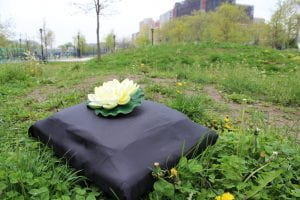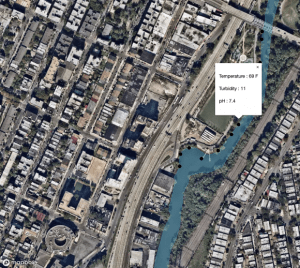By Shelby Smith and Srujana Bhoopanam
We created a device that can be used to measure several water quality indicators. Our aim was to create a means by which people can learn about and acknowledge the natural features of the Bronx River in an approachable and engaging way. In creating our device, AquAlert, as a test pilot for a program that aims to get people invested in water quality, conservation, and the ecological components of cities, we hope to play a role in ushering in a new age of rivers roles in cities.
The ways in which cities learn to coexist with rivers is becoming an increasingly important topic. The start of the 21st century has been characterized by many cities taking a new approach to water and flood control management. However, redesigning urbanites’ relationship with their city’s water poses a substantial challenge. Our project aims to play a role in this reconceptualization process by uncovering elements of the natural world that exists within cities in order to reconnect people with the natural environment within cities.
We chose to use a pH sensor to measure the acid to base ratio of the water, a turbidity sensor in order to detect the purity of the water, as well as an ambient temperature sensor.
We identified thirteen different testing locations ahead of time, each in different sections of the park in order to see how, if at all, the water quality varies further upstream or downstream.
This allowed us to take into different factors that could impact water quality as well, such as proximity to a parking lot or other impervious surfaces, which would result in a great degree of run off and potential impact the pH or turbidity levels.
As the true benefit of our project is in its ability to act as a communication tool, the presentation and narration of our collected data was a key consideration. In order to distill the collected data in such a way that is easy to understand, interactive, and engaging, we created a website to host the garnered data so that it is accessible to the broader public. The website portrays a digital, interactive map of Starlight Park with the various testing locations identified by a lilypad icon. Each icon can be clicked, revealing an expandable window that contains a detailed report of the recorded pH, turbidity, and temperature values, as well as what their values indicate about the current health of the Bronx River.
The benefit of this device, as a communication tool that has a behavioral impact, is only realized if it can be seen by a wide audience. Deploying AquAlert on a citywide scale by placing the devices in publicly accessible bodies of water along parks in the Hudson River, East River, and Bronx River, the device could have an immediate impact.
People could begin to see how the pH, turbidity, and ambient temperature of the water changes over time and – more importantly – begin to recognize what types of human actions impact the quality of the water. Further, By providing a way in which people can understand the relative quality of the waterways and conceptually linking human behavior and development to the health of the water, we believe that a citywide deployment of AquAlert could allow people to feel more connected to the natural, aquatic environment that surrounds them.

